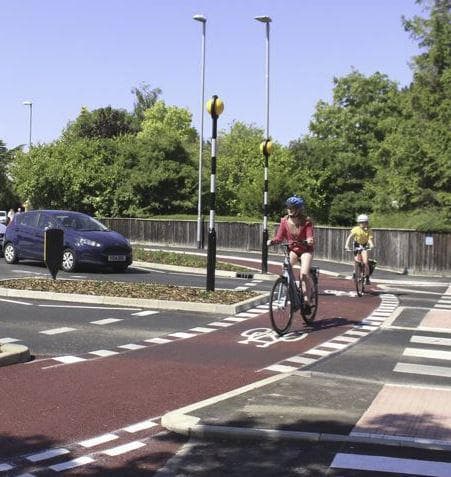
blog: 'Dutch Style' Roundabouts
Thursday 23rd September 2021
In 2018, Royal HaskoningDHV (RHDHV) was commissioned by Cambridgeshire County Council (CCC) to develop an innovative scheme that adopted the key principles of Dutch roundabout design. In the years running up to the work, the roundabout had experienced an above-average number of collisions involving cyclists. Ultimately the priority for the scheme was to enhance safety conditions for all road users, including those more vulnerable, whilst removing barriers to walking and cycling. So, why use Dutch design?
Adopting Dutch Design
The solution was to introduce a ‘Dutch Style’ roundabout which incorporates a segregated orbital cycle path, giving priority for cyclists and pedestrians on the entry and exits of the junction. The key principles of the design were adopted from roundabout design standards advocated by the Dutch SWOV Road Safety Research Institute, which has a proven track record in the Netherlands - to such an extent that they are increasingly being used to replace signalised junctions.
Whilst several previous UK schemes have used elements of ‘Dutch-style’ roundabout design, this scheme is considered to be the first in the UK that incorporates all the principles specified in the Dutch cycle design manual.
Achieving the Final Design
There were a number of steps that took place in order to achieve the final design:
- It was important to work collaboratively with CCC’s cycling experts and Road Safety team to better understand the local challenges.
- RHDHV drew upon empirical research to obtain project assurance on the road safety benefits of the scheme. The designs were additionally subject to independent road safety audits, the results of which were incorporated into the scheme.
- CCC undertook an initial consultation exercise relating to travel issues. Over 1,100 responses were received with 67% of respondents feeling that improvements for walking and cycling were needed along the route. CCC also developed a consultation webpage which featured an animation of the roundabout in operation.

Inspiring Others
The roundabout is the first of its kind within the UK and provides an exemplar for industry professionals to study with a view to similar applications elsewhere. The scheme has become a national demonstrator and has fuelled lively debate amongst transport professionals from across the globe.
Since completion, the project team has been contacted by several UK local authorities/consultants requesting technical advice on the concept. The innovative approach is clearly acting as an inspiration to an industry seeking to implement progressive solutions.
The scheme has also received significant praise from local and national walking and cycling communities – with Matt Barber of Sustrans saying:
“We are really impressed with the Fendon Road Dutch-style roundabout - many of our volunteers have been in touch, letting us know just how good the roundabout is, and that Sustrans must try to ensure many more get built across the UK. This standard should without doubt become the norm in our towns and cities."
The roundabout has improved safety for vulnerable road users, not only preventing injuries and potential fatalities, but also encouraging use of active modes of travel, thus delivering wider health benefits to communities. The scheme also demonstrates that roundabouts can be designed in a manner that provides a suitable alternative to traffic signals which could be applicable to many locations across the UK. Indeed, this year the Greater Cambridge Partnership will be consulting on proposals to fill in many of the ‘missing links’ in the cycle network and there are plans in the pipeline for other Dutch-style roundabouts within Cambridge.
Find out more on the RHDHV website here.
